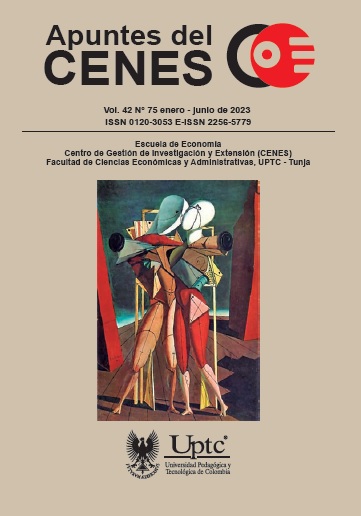Spillovers of COVID-19 on Employment and Income in Peru

Abstract
This paper estimates the spillovers effects of COVID-19 on employment (total, formal, and informal) and real income of a group of Peruvian provinces called “treated or treatment” in the period of the virus 2020- II-2021-IV. These spillovers are associated with the behavior of people who broke the confinement, crowded into relatively small spaces, and did not use protective measures against COVID-19. The measurements of these effects are based on Cao and Dowd (2019), and on the INEI-ENAHO National Household Survey (2022) for the period 2011.I-2021-IV, which is the main database of the study. Two main results of the study are, on the one hand, that COVID-19 and the confinement policies and transfers to the poor and companies contributed on average to more than 50% of the decrease in total employment, formal employment, and real income (of the economically active population employed in the province), and to the increase in informality for the group of provinces covered. On the other hand, the spillovers effects attenuated the negative effects of the decrease in formal employment and real income in said provinces.
Keywords
Covid-19, spillover effect, unemployment, income distribution, Peru
Supplementary File(s)
(Apéndice) (Español)References
- Abadie, A. (2021). Using Synthetic Controls: Feasibility, Data Requirements, and Methodological Aspects. Journal of Economic Literature. 59(2), 391-425. https://doi.org/10.1257/jel.20191450 DOI: https://doi.org/10.1257/jel.20191450
- Andrews, D. W. K. (2003). End-of-Sample Instability Tests. Econometrica, 71(6),1661-1694. https://doi.org/10.1111/1468-0262.00466 DOI: https://doi.org/10.1111/1468-0262.00466
- Angrist, J., Imbens, G. & Rubin, D. (1996). Identification of Causal Effects Using Instrumental Variables. Journal of the American Statistical Association, 91(434), 444-455. https://doi.org/10.1080/01621459.1996.10476902 DOI: https://doi.org/10.1080/01621459.1996.10476902
- Banco Central de Reserva del Perú. (BCRP). (2022). Estadísticas. BCRP.
- Cao J., & Dowd, C. (2018). Estimation and Inference for Synthetic Control Methods with Spillover Effects. PPT. University of Chicago Booth School of Business.
- Cao J., & Dowd, C. (2019). Estimation and Inference for Synthetic Control Methods with Spillover Effects. University of Chicago Booth School of Business.
- Cox., D. (1958). Planning of Experiments. John Wileys & Sons.
- Cunningham, S. (2021). Causal Inference the Mixtape. Yale University Press, New Haven & London. https://doi.org/10.12987/9780300255881 DOI: https://doi.org/10.12987/9780300255881
- Di Stefano R., & Mellace, G. (2020). The Inclusive Synthetic Control Method. Department of Methods and Models for Economics, Territory and Finance. Sapienza University of Rome Via del Castro Laurenziano, Mimeo. https://doi.org/10.2139/ssrn.3737491 DOI: https://doi.org/10.2139/ssrn.3737491
- Ferman, B., & Pinto, C. (2021). Synthetic Controls with Imperfect Pre-treatment Fit. Quantitative Economics,12(4). https://doi.org/10.3982/QE1596 DOI: https://doi.org/10.3982/QE1596
- Grossi, G., Mariani, M., Mattei, A., Lattarulo, P., & Oner, O. (2021). Synthetic Control Group Methods in the Presence of Interference: The Direct and Spillover Effects of Light Rail on Neighborhood Retail Activity. Mimeo. Cambridge University.
- Green, D., & Gerber, A. (2010). The Stable Unit Treatment Value Assumption (SUTVA) and Its Implications for Social Science RCTs. In Presentation at the Conference on Empirical Legal Studies, Yale Law School, November 5, 2010. https://community.lawschool.cornell.edu/wp-content/uploads/2020/12/Green-presentation-on-SUTVA-for-CELS.pdf
- Green, D., & Gerber, A. (2012). Field Experiments: Design, Analysis, and Interpretation. Norton.
- Huntington-Klein, N. (2022). The Effect an Introduction to Research Design and Causality. CRC Press. https://doi.org/10.1201/9781003226055 DOI: https://doi.org/10.1201/9781003226055
- INEI 2022. Estadísticas de seguridad ciudadana. INEI. https://www.inei.gob.pe/biblioteca-virtual/boletines/estadisticas-de-seguridad-ciudadana/1/
- INEI-ENAHO. (2022). Encuesta Nacional de Hogares, años del 2011 al 2020. INEI.
- Jaramillo, M., & López, K. (2021). Políticas para combatir la pandemia de COVID-19. Grade Documento de Investigación, (12). https://www.grade.org.pe/publicaciones/politicas-para-combatir-la-pandemia-de-covid-19/Johns Hopkins (s.f.). COVID-19 Map. Johns Hopkins University. https://coronavirus.jhu.edu/map.html
- Lim J., Maung, S., Tan, S., Ong, J., Lim, J., Koo, H., Sun, M., Park, K., TanI, J., Yoong, A., Cook, B. & Dickens, L. (2021). Estimating Direct and Spill-over Impacts of Political Elections on COVID-19 Transmission Using Synthetic Control Methods. PLOS Computational Biolog., 1-15. https://doi.org/10.1371/journal.pcbi.1008959 DOI: https://doi.org/10.1371/journal.pcbi.1008959
- Ministerio de Economía y Finanzas (MEF). (2022). Transparencia Económica. Mineco. https://apps5.mineco.gob.pe/bingos/mantenimiento/Navegador/default.aspx
- MINSA. (2022). Estadísticas del COVID 19. MINSA. https://covid19.minsa.gob.pe/sala_situacional.asp
- Mitze J., Kosfeld, R., Rode, J. & Wälde, K. (2020). Face Masks Considerably Reduce COVID-19 Cases in Germany. PNAS, 117(51), pp. 1-9, https://doi.org/10.1073/pnas.2015954117 DOI: https://doi.org/10.1073/pnas.2015954117
- Mundo LR. (2020, 20 dic.). Perú es noticia en el mundo por aglomeraciones en compras navideñas. La República. https://larepublica.pe/mundo/2020/12/20/peru-es-noticia-en-el-mundo-por-aglomeraciones-en-compras-navidenas/Our World Data. (2022). COVID-19 Data. https://ourworldindata.org/
- Redacción Perú 21. (2020, 11 abr.). Coronavirus en Perú: Problemas para congelar alimentos en hogares habrían contribuido a aglomeraciones. Perú 21. https://peru21.pe/economia/problemas-para-congelar-alimentos-en-hogares-habrian-contribuido-a-aglomeraciones-noticia/?ref=p21r
- Rubin D. (1980). Randomization Analysis of Experimental Data: The Fisher Randomization Test Comment. Journal of the American Statistical Association, 75(371), 591-593. https://doi.org/10.1080/01621459.1980.10477517 DOI: https://doi.org/10.2307/2287653
- Shi, C., Sridhar, D., Misra, V., & Blei, D. (2022). On the Assumptions of Synthetic Control Methods. In Proceedings of the 25th International Conference on Artificial Intelligence and Statistics (AISTATS) 2022, Valencia, España.
- Tello, M.D. (2022). Controles sintéticos y estrategia de dosis: un análisis provincial exploratorio de los efectos del COVID-19 en los ingresos, empleo y pobreza en el Perú, 2011-2020. Informe final CIES.
- World Bank. (2022). World Development Indicators. World Bank.
- Zhang, Z., Owen, G., Green, M., Buchan, I., &Barr, B. (2022). Evaluating the Impacts of Tiered Restrictions Introduced in England, During October and December 2020 on COVID-19 Cases: A Synthetic Control Study. BMJ Open,12(4), 1-7. http://dx.doi.org/10.1136/bmjopen-2021-054101 DOI: https://doi.org/10.1136/bmjopen-2021-054101
- Zhou, F., Yu, T., Du, R., Fan, G., Liu, Y., & Liu, Z. (2020). Clinical Course and Risk Factors for Mortality of Adult Inpatients with COVID-19 in Wuhan, China: A Retrospective Cohort Study. Lancet, 395(10229), 1054-1062. https://doi.org/10.1016/S0140-6736(20)30566-3 DOI: https://doi.org/10.1016/S0140-6736(20)30566-3
